Kłodzko
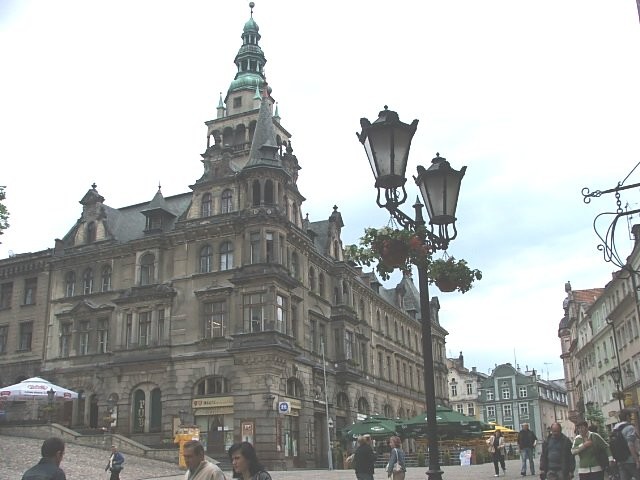
Kłodzko Town Hall on Plac Bolesława Chrobrego – the old town center
Distance
11 km NE, 47 km N, 21 km SV, 41 km N, 74 km SE, 79 km NE, 23 km NE, 35 km V, 39 km NE, 22 km NV, 55 km E, 43 km E, 31 km E, 14 km SV, 66 km NE, 61 km NV, 57 km NV, , 23 km NE, 41 km NE, 19 km E 89 no, Brzeg 99 now, Opole 109 no, Bardo 11 no, Ząbkowice Śląskie 23 no, Kamieniec Ząbkowicki 23 no, Strzelin 66 now, ziebice 41 now, Otmuchów 43 now, Paczków 31 no, Grodków 79 no, Nysa 55 now, Złoty Stok 19 Island, Lądek-Zdrój 24 Sun, Stronie Śląskie 30 Sun, Bystrzyca Kłodzka 17 p.Population
30.300 (1998)
Location and history
Kłodzko is located in southwestern Poland, in the Lower Silesia region, south of the regional capital Wrocław and near the Czech border. In terms of terrain, the city lies in a broad depression (Kotlina Kłodzka), between mountains that count Góry Sowie and Góry Bardzkie to the north and east, Góry Złote and Masyw Śnieżnika to the southeast, and Góry Bystrzyckie to the southwest and west. The lowering of the mountain and the city is flooded by the river Nysa Kłodzka. Kłodzko is an old town and capital of the Kłodzko area, now the administrative center city of Kłodzko Powiat (district) and a communications and tourist center.
Kłodzko is first mentioned by the Czech chronicle Kosmas (with the name form “Cladsco”) during the year 981. In the 10th year. the area around Klodzko belonged to the West Slavic tribe ślężanie, but towards the end of the century the area came under Czech rule. The castle on the left bank was built by Czech princes as a defense against Poland. The Polish king Bolesław Chrobry took Kłodzko several times in order to strengthen his position in Silesia and because the area was very important in strategic terms. However, the place came back on Czech hands only for a short period – 1050-1096 – to return to Poland. In the 12th-13th centuries. the city was strongly developed by German migrants, originally summoned by the Czech king Ottokar II Přemysl. The city at the foot of the fortress mound was surrounded by a defensive wall. The city, already in 1114, was designated as “urbs” (town), is known to have had market town rights in 1275. During the Middle Ages, Kłodzko was owned by various kings and princes and also served for a period as an independent county, which however, was taken over by the Habsburg dynasty from 1560. In the 18th century. Prussia succeeded in separating Silesia from the other lands of the Habsburg monarchy, and from 1763 Kłodzko was integrated into Prussia. The beginning of the 19th century. was marked by the Napoleonic Wars; in 1807, Kłodzko was besieged by the French, who also plundered the surrounding towns. 2nd half of the 19th century. was, on the other hand, characterized by economic prosperity; new health spas emerged and railway lines were built. After World War II, the end of which was disastrous for the German population in the area, followed a new era for the city, now part of Poland. Migrants from other parts of Poland settled in large numbers in Kłodzko, including repatriated Polish citizens from the old Polish eastern regions. In 1997, the city was hit by a catastrophic flood.
In the city there is a certain industry within, among other things. food, metals, wood and construction. The majority of the population feeds on trade and service.
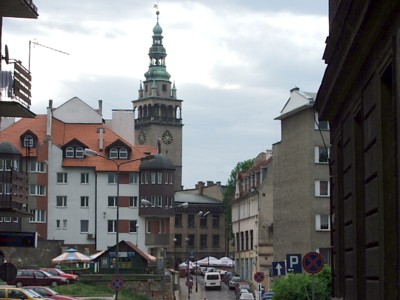
Kłodzko. The northwestern part of the center facing the town hall tower
Tourist attractions
The main fortress (Twierdza Główna)
The fortress is a unique building monument in the field of military architecture. The first fortifications on the fort (Forteczna Góra) date from the 9th century. Over the centuries, the fort underwent numerous redevelopments, extensions and alterations to meet the current demands of warfare and military defense.
In 1114, the original fortification of wood, which was rebuilt in 1129 and burned the seat of the castle, burned down. Around 1300, the fortress had been developed into a high-class castle with both defense and housing facilities. During the Middle Ages, the stronghold was further expanded, while in the 16th century a lower castle was built and the walls expanded. A highlight reached the fortress under Friedrich II the Great, which made it one of the most powerful bastions in Prussian Silesia.
The very extensive fortress plant today covers approx. 30 ha. and part of the facility is accessible to tourists. From the fortress there is a beautiful view of the city and the valley (Kotlina Kłodzka).
On the opposite (eastern) side of the river lies the hill Owcza Góra (“sheep mountain”) with the fort of Fort Owcza Góra.
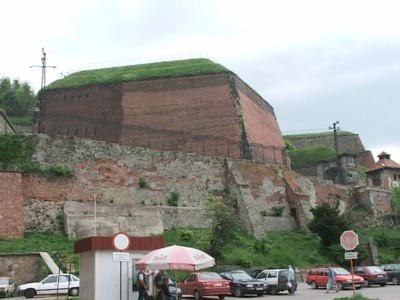
The main fortress seen from ul.Czeska
Virgin Mary's Ascension Church (Kościół Wniebowzięcia Najświętszej Marii Panny)
The church was mentioned as early as 1194, while the construction of the present church was begun by the Johns in the middle of the 14th century. – in the place where a former church had stood. It is a bedotic, three-tiered building with 2 side chapels (south and north). In 1624-93 the church was rebuilt in Baroque style. The church is often mentioned as the main attraction in Kłodzko, both because of its architectural values and the church's equipment. The main altar is from 1727-29, made of marble, stucco and wood by JASiegwitz. The late Gothic baptismal font dates from 1517.
Godmother of the Rosary Church (Kościół Matki Boskiej Różańcowej) and Franciscan
The church is a late-Baroque three-story building with four octagonal chapels on either side of the main ship. The church building was erected in its present form in 1628-31. The original church at the same site dates from the 14th century. The neo-Renaissance style is from the last quarter of the 19th century. Also highlighted are the frescoes by Felix Anton Scheffler, a Silesian Baroque painter. The building was damaged during the 1997 flood.
The adjacent Franciscan monastery is listed in the first half of the 18th century. at the site of a former building and around a square inner courtyard. In the refectory are frescoes by FA Scheffler from 1744.
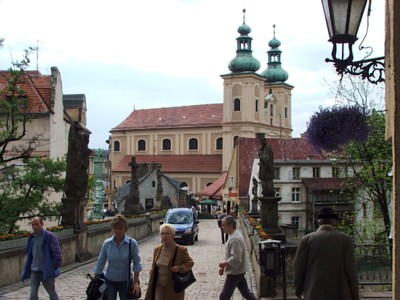
The Gothic bridge over Młynówka seen to the southeast. In the background Godmother of the Rosary Church
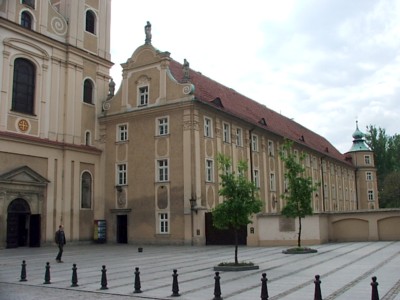
The West Wing of the Franciscan Monastery. To the left Godmother of the Rosary Church
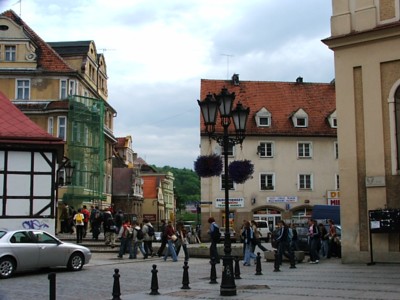
Place Franciszkański
The Gothic Bridge
This medieval stone bridge from the 13th to 14th century. leads over the Młynówka Canal. The bridge is similar in shape and equipment to the Charles Bridge in Prague, although the bridge in Klodzko is considerably smaller. The bridge is adorned with 6 figures of stone added in the Baroque era.
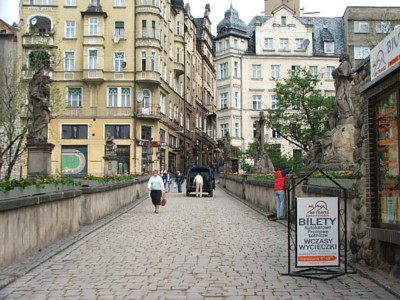
The Gothic Bridge. In the background, the street ul.Wita Stwosza, leading to Bolesław Chrobry Square and City Hall
Church of Christ the King (Kościół Chrystusa Krolla)
The church is picturesque at the foot of the Main Fortress (east of the fort and west of the river). The building, which dates from the 13th century, is the single ship with chapels on the north side.
City Hall
at Plac Bolesława Chrobrego (Square) The first building was probably erected in the 14th century; it burned in 1366 and was rebuilt in 1400. Rebuilding took place both in the 16th and 17th centuries. The town hall's current appearance is due to a neo-Renaissance-style remodeling in 1887-90 following drawings by architect Ewald Berger. The least modified part of the building is the tower that originally emerged at the end of the 14th century.
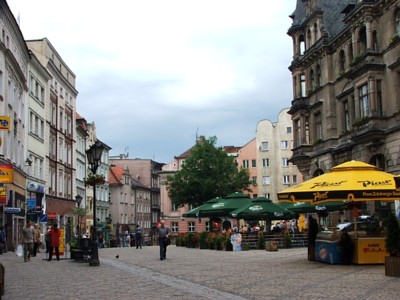
South side of Bolesław Chrobry Square. To the right City Hall
Townhouses in the Old Town
In the Old Town, most of the preserved and preserved residential buildings are located in Kłodzko. Some date from the beginning of the 17th century. The most interesting stands at ul. Czeskiej, ul. Armii Krajowej and pl. Bolesława Chrobrego. In total, there are about 400 listed buildings in the city.
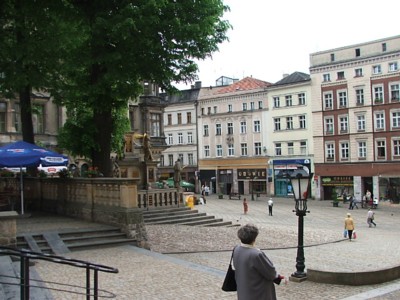
The western side of Plac Bolesława Chrobrego. To the left the City Hall
The underground tourist route
was created in connection with engineering work aimed at protecting the old town from a disaster that threatened it as a result of changes in the level of groundwater, poor foundations, etc. The route includes a selection of the course of excavations and corridors. The route is a unique attraction, at least at the regional level.
Kłodzko Area Museum
The Muzeum Ziemi Kłodzkiej is housed in the former Jesuit boarding school, a Baroque-style building dating from 1664, whose current appearance is due to a remodeling in the 18th century. The museum's collections are about the city, the region, history, nature and art. The beautiful interior of the building must be highlighted: the library, the two-storey concert hall with dome, the Golden Hall and the meeting room. The largest collections include objects of art, coins, Silesian watches and glass.
Jesuiterkollegiet
The former Jesuit college is a three-storey Baroque building, built 1654-90. After the order was repealed, the house served as a Catholic high school from 1787 to 1945. Now the building is first and foremost a general high school.
Bymuren
The city wall was built of stone at the end of the 13th century. and expanded with brick in 1426 and 1469. The wall surrounded the city to the south and west, the other sides being protected by the fortress. Preserved remains of the wall can be found by the Młynówka Canal.
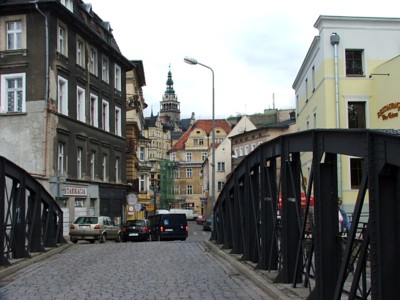
The bridge over Nysa at Grottger Street – facing the old town.
Surrounding Area
The Kłodzko Valley and the surrounding mountain ranges on all sides a scenic area with many opportunities for both car, bicycle and hiking tourism as well as mountain climbing in summer and skiing in winter.
Powiat Kłodzki Klodzko district
Accommodation
Booking.com
Kłodzko (The official site of the municipality) – in Polish, English, German and Czech
Gmina Kłodzko Kłodzko land municipality
Eating Out:
Kłodzko (The official site of the municipality) – in Polish, English, German and Czech
Gmina Kłodzko Kłodzko land municipality
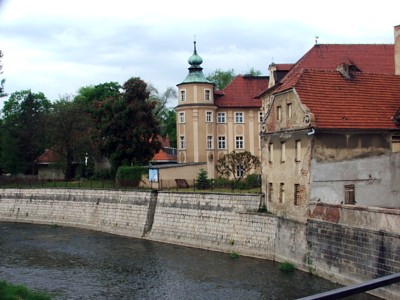
The river Nysa Kłodzka at the Franciscan Monastery
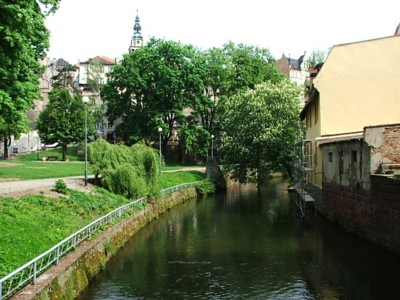
By Młynówka. In the background the town hall tower
Other Internet sites and sources
Kłodzko (The official site of the municipality) – in Polish, English, German and Czech
Gmina Kłodzko Kłodzko land municipality
Translated into English by Google Translate. Spangshus.dk accept no liability for any errors or omissions in translation.
Map

Rating
Search
Most used tags
churches (205) Castles (86) Monasteries (79) Town walls (74) Lakes (71) Town halls (67) Rivers (65) Castles1 (62) Mansions (55) Museums (51) Regional museums (38) Town gates (36) Abbey churches (35) Castle ruins (30) Cathedrals (26) Forests (25) Health resorts (24) Water sports (23) Mounds (23) National parks (22)Click for all tags
Denne side er også tilgængelig på dansk. This page and contents is (c) Copyright 2018- www.spangshus.dk. Based on Inviator software by ISCA Software